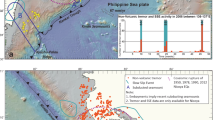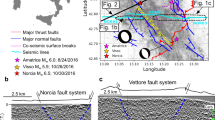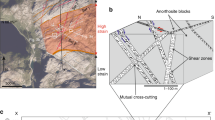Abstract
Volcano seismicity is an important tool in monitoring and forecasting activity at volcanoes globally. Volcanic earthquakes show diverse spectral characteristics, of which shallow long-period (low-frequency) seismicity and long-duration tremor are generally interpreted as indicators of fluid migration, and as potential eruption precursors. Here we show that a common low-cohesion volcanic sediment from the Campi Flegrei caldera (Italy) produces low-frequency and long-duration seismicity as it undergoes deformation in dry conditions. We employed acoustic-emission rock-deformation experiments at a range of strain rates to produce events that, when normalized for scale, were spectrally indistinguishable from the long-period and tremor seismicity observed in natural volcanic settings. The generation of these signals was enhanced at lower laboratory strain rates. Correlated X-ray tomography of the samples before and after deformation constrained the source as distributed damage.
This is a preview of subscription content, access via your institution
Access options
Access Nature and 54 other Nature Portfolio journals
Get Nature+, our best-value online-access subscription
$29.99 / 30 days
cancel any time
Subscribe to this journal
Receive 12 print issues and online access
$259.00 per year
only $21.58 per issue
Buy this article
- Purchase on Springer Link
- Instant access to full article PDF
Prices may be subject to local taxes which are calculated during checkout




Similar content being viewed by others
Data availability
The data used in this work are held at the National Geoscience Data Centre, as item number 163527. These include the 1 Hz deformation logs, 10 MHz 12-channel AE event recordings, raw XCT slices from before and after deformation, and the processing code used to generate the statistical analyses and sonograms54.
References
Scarpa, R., Tilling, R. I. & McNutt, S. R. in Monitoring and Mitigation of Volcano Hazards https://doi.org/10.1007/978-3-642-80087-0_3 (Springer, 1996).
Chouet, B. A. Long-period volcano seismicity: its source and use in eruption forecasting. Nature 380, 309–316 (1996).
Kilburn, C. R. J. Multiscale fracturing as a key to forecasting volcanic eruptions. J. Volcanol. Geotherm. Res. 125, 271–289 (2003).
Cortés, G. et al. Parallel system architecture (PSA): an efficient approach for automatic recognition of volcano-seismic events. J. Volcanol. Geotherm. Res. 271, 1–10 (2014).
Benson, P. M., Vinciguerra, S., Meredith, P. G. & Young, R. P. Spatio-temporal evolution of volcano seismicity: a laboratory study. Earth Planet. Sci. Lett. 297, 315–323 (2010).
Lokmer, I., Saccorotti, G., Di Lieto, B. & Bean, C. J. Temporal evolution of long-period seismicity at Etna Volcano, Italy, and its relationships with the 2004–2005 eruption. Earth Planet. Sci. Lett. 266, 205–220 (2008).
Clarke, J. et al. The relation between viscosity and acoustic emissions as a laboratory analogue for volcano seismicity. Geology 47, 499–503 (2019).
McNutt, S. R. in Monitoring and Mitigation of Volcano Hazards (eds Scarpa, R., Tilling, R. I. & McNutt, S. R.) 99–146 https://doi.org/10.1007/978-3-642-80087-0_3 (Springer, 1996).
Harrington, R. M. & Benson, P. M. Analysis of laboratory simulations of volcanic hybrid earthquakes using empirical Green’s functions. J. Geophys. Res. Solid Earth 116, 1–13 (2011).
Jolly, A. D., Neuberg, J., Jousset, P. & Sherburn, S. A new source process for evolving repetitious earthquakes at Ngauruhoe volcano, New Zealand. J. Volcanol. Geotherm. Res. 215–216, 26–39 (2012).
Kennedy, B. M. et al. Pressure controlled permeability in a conduit filled with fractured hydrothermal breccia reconstructed from ballistics from Whakaari (White Island), New Zealand. Geosciences 10, 138 (2020).
Chardot, L., Jolly, A. D., Kennedy, B. M., Fournier, N. & Sherburn, S. Using volcanic tremor for eruption forecasting at White Island volcano (Whakaari), New Zealand. J. Volcanol. Geotherm. Res. 302, 11–23 (2015).
Barberi, F., Corrado, G., Innocenti, F. & Luongo, G. Phlegraean Fields 1982–1984: brief chronicle of a volcano emergency in a densely populated area. Bull. Volcanol. 47, 175–185 (1984).
Armienti, P., Barberi, F. & Innocenti, F. A model of the Phlegraean Fields magma chamber in the last 10,500 years. Bull. Volcanol. 47, 349–358 (1984).
Scarpa, R., Tilling, R. I., Barberi, F. & Carapezza, M. L. in Monitoring and Mitigation of Volcano Hazards 771–786 https://doi.org/10.1007/978-3-642-80087-0_23 (Springer, 1996).
Hicks, A. & Few, R. Trajectories of social vulnerability during the Soufrière Hills volcanic crisis. J. Appl. Volcanol. 4, 10 (2015).
Kilburn, C. R. J., De Natale, G. & Carlino, S. Progressive approach to eruption at Campi Flegrei caldera in southern Italy. Nat. Commun. 8, 15312 (2017).
Brown, S. K., Sparks, R. S. J. & Jenkins, S. F. in Global Volcanic Hazards and Risk (eds Loughlin, S. C., Sparks, S., Brown, S. K., Jenkins, S. F. & Vye-Brown, C.) 359–369 https://doi.org/10.1017/CBO9781316276273.025 (Cambridge Univ. Press, 2015).
Orsi, G., D’Antonio, M., Vita, Sde & Gallo, G. The Neapolitan Yellow Tuff, a large-magnitude trachytic phreatoplinian eruption: eruptive dynamics, magma withdrawal and caldera collapse. J. Volcanol. Geotherm. Res. 53, 275–287 (1992).
Deino, A. L., Orsi, G., de Vita, S. & Piochi, M. The age of the Neapolitan Yellow Tuff caldera-forming eruption (Campi Flegrei caldera—Italy) assessed by 40Ar/39Ar dating method. J. Volcanol. Geotherm. Res. 133, 157–170 (2004).
Dvorak, J. J. & Berrino, G. Recent ground movement and seismic activity in Campi Flegrei, southern Italy: episodic growth of a resurgent dome. J. Geophys. Res. 96, 2309–2323 (1991).
Orsi, G., De Vita, S. & di Vito, M. The restless, resurgent Campi Flegrei nested caldera (Italy): constraints on its evolution and configuration. J. Volcanol. Geotherm. Res. 74, 179–214 (1996).
De Natale, G. et al. The Campi Flegrei caldera: unrest mechanisms and hazards. Geol. Soc. Lond. Spec. Publ. 269, 25–45 (2006).
Langella, A. et al. The Neapolitan Yellow Tuff: an outstanding example of heterogeneity. Constr. Build. Mater. 136, 361–373 (2017).
Moon, V. G. Geotechnical characteristics of ignimbrite: a soft pyroclastic rock type. Eng. Geol. 35, 33–48 (1993).
Quane, S. L. & Russell, J. K. Rock strength as a metric of welding intensity in pyroclastic deposits. Eur. J. Mineral. 15, 855–864 (2003).
Binal, A. Prediction of mechanical properties of non-welded and moderately welded ignimbrite using physical properties, ultrasonic pulse velocity, and point load index tests. Q. J. Eng. Geol. Hydrogeol. 42, 107–122 (2009).
Heap, M. J. et al. Quantifying the role of hydrothermal alteration in creating geothermal and epithermal mineral resources: the Ohakuri ignimbrite (Taupō Volcanic Zone, New Zealand). J. Volcanol. Geotherm. Res. 390, 106703 (2020).
Fazio, M., Alparone, S., Benson, P. M., Cannata, A. & Vinciguerra, S. Genesis and mechanisms controlling tornillo seismo-volcanic events in volcanic areas. Sci. Rep. 9, 7338 (2019).
Kendrick, J. E. et al. Tracking the permeable porous network during strain-dependent magmatic flow. J. Volcanol. Geotherm. Res. 260, 117–126 (2013).
Burlini, L. et al. Seismicity preceding volcanic eruptions: new experimental insights. Geology 35, 183–186 (2007).
Main, I. Earthquake scaling. Nature 357, 27–28 (1992).
Hatton, C. G., Main, I. G. & Meredith, P. G. A comparison of seismic and structural measurements of scaling exponents during tensile subcritical crack growth. J. Struct. Geol. 15, 1485–1495 (1993).
Aki, K. & Koyanagi, R. Deep volcanic tremor and magma ascent mechanism under Kilauea, Hawaii. J. Geophys. Res. 86, 7095–7109 (1981).
Benson, P. M., Thompson, B. D., Meredith, P. G., Vinciguerra, S. & Young, R. P. Imaging slow failure in triaxially deformed Etna basalt using 3D acoustic-emission location and X-ray computed tomography. Geophys. Res. Lett. 34, L03303 (2007).
Fazio, M., Benson, P. M. & Vinciguerra, S. On the generation mechanisms of fluid-driven seismic signals related to volcano-tectonics. Geophys. Res. Lett. 44, 734–742 (2017).
Heap, M. J. et al. The influence of water on the strength of Neapolitan Yellow Tuff, the most widely used building stone in Naples (Italy. Bull. Volcanol. 80, 51 (2018).
Ulusay, R. & Hudson, J. A. (eds) The Complete ISRM Suggested Methods for Rock Characterization, Testing and Monitoring: 1974–2006 135–137 (ISRM and Turkish National Group of ISRM, 2007).
Townend, E. et al. Imaging compaction band propagation in Diemelstadt sandstone using acoustic emission locations. Geophys. Res. Lett. 35, L15301 (2008).
Smith, R., Sammonds, P. R. & Kilburn, C. R. J. Fracturing of volcanic systems: experimental insights into pre-eruptive conditions. Earth Planet. Sci. Lett. 280, 211–219 (2009).
Lockner, D. A., Byerlee, J. D., Kuksenko, V., Ponomarev, A. & Sidorin, A. Quasi-static fault growth and shear fracture energy in granite. Nature 350, 39–42 (1991).
Thompson, B. D. Observations of premonitory acoustic emission and slip nucleation during a stick slip experiment in smooth faulted Westerly granite. Geophys. Res. Lett. 32, L10304 (2005).
Harnett, C. E., Benson, P. M., Rowley, P. & Fazio, M. Fracture and damage localization in volcanic edifice rocks from El Hierro, Stromboli and Tenerife. Sci. Rep. 8, 1942 (2018).
Bean, C. J. et al. Long-period seismicity in the shallow volcanic edifice formed from slow-rupture earthquakes. Nat. Geosci. 7, 71–75 (2014).
Neuberg, J., Luckett, R., Baptie, B. & Olsen, K. Models of tremor and low-frequency earthquake swarms on Montserrat. J. Volcanol. Geotherm. Res. 101, 83–104 (2000).
Massonnet, D. & Feigl, K. L. Radar interferometry and its application to changes in the Earth’s surface. Rev. Geophys. 36, 441–500 (1998).
Benson, P. M., Vinciguerra, S., Meredith, P. G. & Young, R. P. Laboratory simulation of volcano seismicity. Science 322, 249–252 (2008).
Wong, T. & Baud, P. The brittle-ductile transition in porous rock: a review. J. Struct. Geol. 44, 25–53 (2012).
Vajdova, V., Zhu, W., Natalie Chen, T.-M. & Wong, T. Micromechanics of brittle faulting and cataclastic flow in Tavel limestone. J. Struct. Geol. 32, 1158–1169 (2010).
Barberi, F. et al. The Campanian ignimbrite: a major prehistoric eruption in the Neapolitan area (Italy). Bull. Volcanol. 41, 10–31 (1978).
Scarpati, C., Cole, P. & Perrotta, A. The Neapolitan Yellow Tuff—a large volume multiphase eruption from Campi Flegrei, Southern Italy. Bull. Volcanol. 55, 343–356 (1993).
Benson, P. M. et al. Laboratory simulations of fluid-induced seismicity, hydraulic fracture, and fluid flow. Geomech. Energy Environ. 24, 100169 (2020).
Fairhurst, C. E. & Hudson, J. A. Draft ISRM suggested method for the complete stress-strain curve for intact rock in uniaxial compression. Int. J. Rock. Mech. Min. Sci. 36, 279–289 (1999).
Rowley, P., Benson, P. P. & Beam, C. J. Deformation and acoustic emission of Neapolitan Yellow Tuff (NERC EDS National Geoscience Data Centre); https://doi.org/10.5285/321869e2-e2d2-4e67-ba28-e961ad8bb79f (accessed 16 February 2021).
Acknowledgements
We are grateful to E. Butcher for the sample preparation work, E. Pegge for collating the event classifications and F. Cappuccio for measuring the postdeformation porosity values. We acknowledge support from the Zeiss Global Centre at the University of Portsmouth for providing the X-ray microscopy facilities used in this study, and the assistance of the National Geoscience Data Centre in accommodating our dataset.
Author information
Authors and Affiliations
Contributions
P.R. drafted the paper. P.R. and P.B. carried out the laboratory experiments. P.R., P.B. and C.B. discussed results, carried out the analysis and edited the draft paper.
Corresponding author
Ethics declarations
Competing interests
The authors declare no competing interests.
Additional information
Peer review information Nature Geoscience thanks Christopher Kilburn, Ben Kennedy and the other, anonymous, reviewer(s) for their contribution to the peer review of this work. Primary Handling Editor(s): Stefan Lachowycz.
Publisher’s note Springer Nature remains neutral with regard to jurisdictional claims in published maps and institutional affiliations.
Supplementary information
Supplementary Data 1
Dimensional data and calculations to generate the volumetric strain value for the slow deformation experiment.
Rights and permissions
About this article
Cite this article
Rowley, P., Benson, P.M. & Bean, C.J. Deformation-controlled long-period seismicity in low-cohesion volcanic sediments. Nat. Geosci. 14, 942–948 (2021). https://doi.org/10.1038/s41561-021-00844-8
Received:
Accepted:
Published:
Issue Date:
DOI: https://doi.org/10.1038/s41561-021-00844-8
This article is cited by
-
Distributed dynamic strain sensing of very long period and long period events on telecom fiber-optic cables at Vulcano, Italy
Scientific Reports (2023)
-
Exploring microstructure and petrophysical properties of microporous volcanic rocks through 3D multiscale and super-resolution imaging
Scientific Reports (2023)
-
A Review of the Source Characteristics and Physical Mechanisms of Very Long Period (VLP) Seismic Signals at Active Volcanoes
Surveys in Geophysics (2023)



